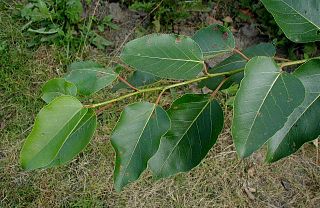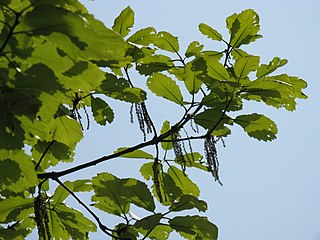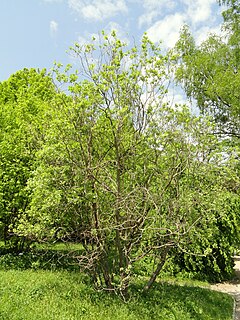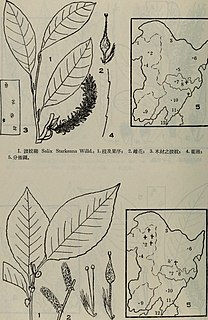
The balsam poplars are a group of about 10 species of poplars, indigenous to North America and eastern Asia, distinguished by the balsam scent of their buds, the whitish undersides of their leaves, and the leaf petiole being round in cross-section. They are large deciduous trees, 30–60 m tall, with leaves with a rounded base, pointed apex, and a whitish waxy coating on the underside of the leaf; this latter distinguishes them from most other poplars. The name is derived from the pleasant balsam smell of the opening buds and leaves in spring, produced by a sticky gum on the buds which also helps protect the buds from insect damage. The balsam poplars are light-demanding trees that require considerable moisture. Poplars are tolerant of very cold conditions, occurring further north than other poplars except for the aspens. The poplars in Southern California are tolerant of 100 plus degree heat. They grow along dry washes and dry riverbed‘s. The dry washes and dry riverbeds will have flowing water when it rains sufficiently. Their leaves hang down and are at an edge to the sun. This may be another factor why they can take the high heat. Their leaves tremble in the slightest breeze like the quaking aspen

Quercus aliena, the galcham oak or oriental white oak, is a species of oak in the family Fagaceae, in the white oak section Quercus.
Populus adenopoda, known commonly as the Chinese aspen, is a species of poplar found in China. The trees can reach a maximum height of 30 metres, and occur on mountain slopes at elevations of 300–2500 metres. Wood from the trees is used in construction and furniture production, as well as timber, farm tools, and wood pulp.
Prunus mugus is a species of cherry found in Yunnan province of China and nearby areas of Myanmar and Tibet. A prostrate shrub 1 m tall, it prefers to grow in thickets in the krummholz zone on mountain slopes from 3200 to 3,700 m or even 4,075 metres (13,400 ft) above sea level. Heinrich von Handel-Mazzetti, who discovered it, named the species after Pinus mugo, the dwarf mountain pine.

Salix aegyptiaca, known as the Persian willow, is a large shrub or small tree from the genus of willow (Salix) with red branches that are tomentose in the first two years and leaves up to 15 centimeters long. The natural range of the species is in the Caucasus and in western Asia. It is cultivated in many countries.

Salix argyracea is a large shrub from the genus of willow (Salix) with up to 10 centimeters long leaf blades with a felty hairy and shiny underside. The natural range of the species is in Kazakhstan, Kyrgyzstan, and China.

Salix argyracea, the smooth willow, is a small shrub from the genus of willow (Salix). It is found in the mountainous areas of several European countries.
Salix capusii is a large shrub from the genus of the willow (Salix) with chestnut-brown branches and 4 to 5 centimeters long, gray-blue leaf blades. The natural range of the species is in Afghanistan, Tajikistan, Pakistan, and China.
Salix cathayana is a strongly branched shrub from the genus of the willow (Salix) with brown or gray-brown, young tomentose hairy branches. The leaf blades have lengths of 1.5 to 5.2 centimeters. The natural range of the species is in the north of China.
Salix balfouriana is a shrub or small tree from the genus of willow (Salix) with reddish black and tomentose hairy young twigs and up to 8 leaf blades, rarely 18 centimeters long. The natural range of the species is in China.
Salix breviserrata is a species of willow belonging to the family Salicaceae. It is found in southern Europe in the Alps, and in the Iberian Peninsula in the Cantabrian Mountains, especially in the Picos de Europa, Somiedo, and the Sierra and Valle del Híjar.

Salix appendiculata is a plant from the willow genus (Salix). They can be found in France, Italy, Central and Eastern Europe, and on the Balkan Peninsula.

Salix caesia is a small shrub in the genus Salix, the willows. It is widespread, mainly in Asia.

Salix starkeana is a small, prostrate shrub from the genus of willows (Salix) with red-brown to purple-red, bare branches and olive-green leaf tops. The natural range of the species is in Europe and in northern Asia.
Salix alatavica is a small shrub from the genus of willow (Salix). It is native to mountainous slopes in Asia, in Kazakhstan, southern Russia, Mongolia, and northern China.
Salix caspica is a plant from the willow genus (Salix) within the willow family (Salicaceae). The natural range extends from eastern European Russia to far western China.
Salix boseensis is a shrub from the genus of willow (Salix) with initially brownish, frosted and bare branches and 6 to 9 centimeters long leaf blades. The natural range of the species is in China.
Salix anticecrenata is a low, pillow-shaped shrub from the genus of willow (Salix) with about 1.5 centimeters long leaf blades. The natural range of the species is in Nepal and China.
Salix atopantha is a small shrub from the genus of the willow (Salix) with up to 4 centimeters long, dull brown leaf blades on top. The natural range of the species is in China.
Salix carmanica is a species of willow found in Iran, in Afghanistan, and in China where it is cultivated. It large shrub with blue-green bark and yellowish, drooping branches. The leaf blades reach lengths of 3 to 5 centimeters, with young shoots even more.







